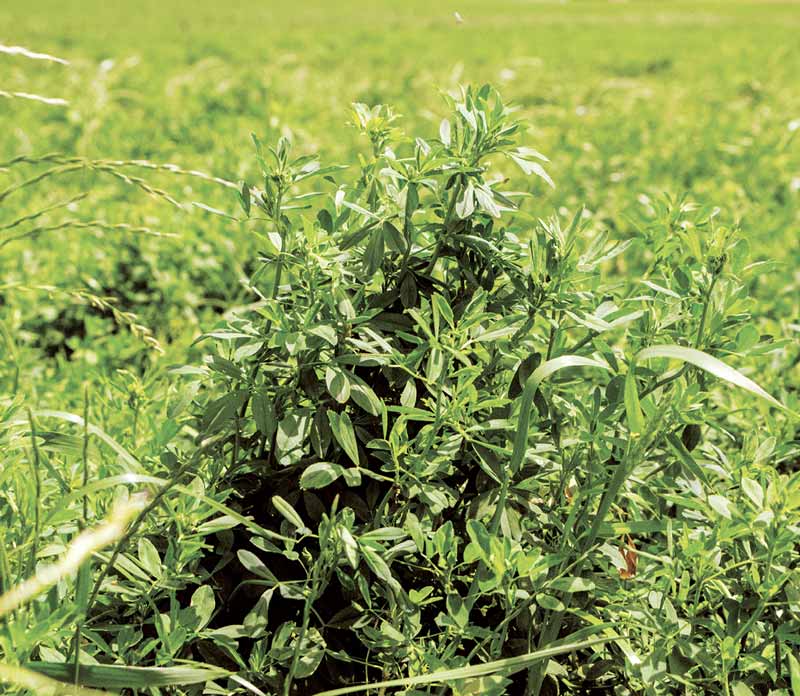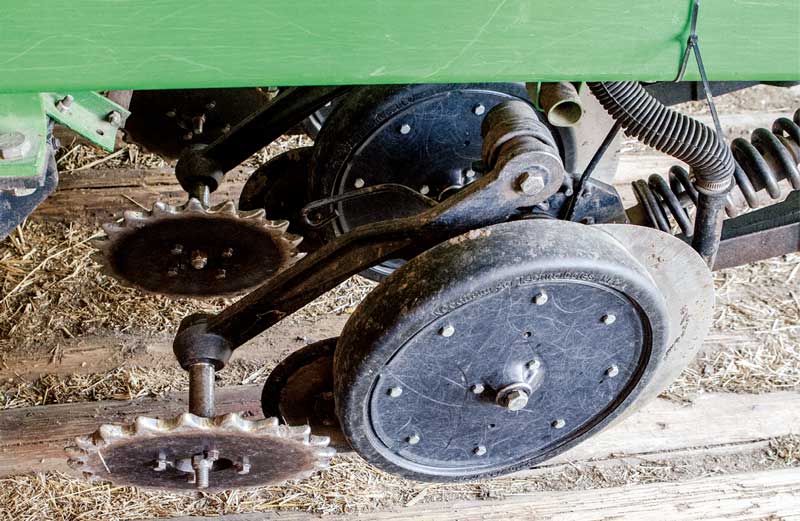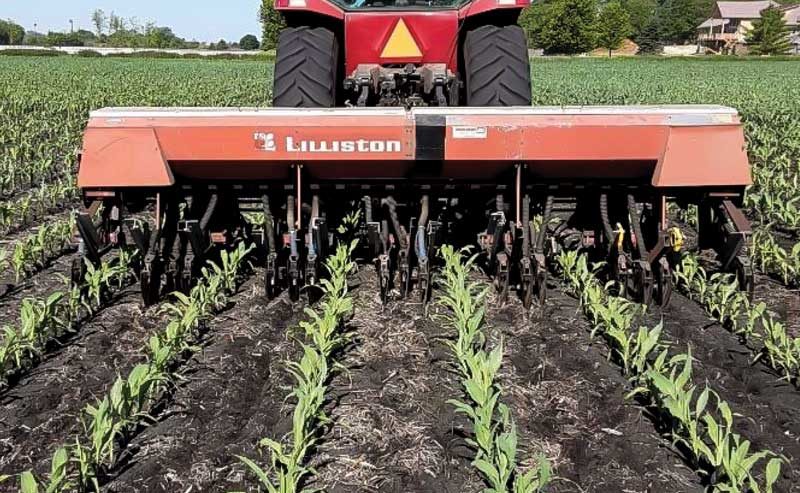Pictured Above: INTERSEEDING EXPERIMENTS. For corn no-tilled after soybeans, Tom Burlingham likes to interseed a cover crop at about V3-V4. He uses a Lilliston grain drill, with the disks rearranged to seed five sets of three rows of a mix of ryegrass, cowpeas, rapeseed, flax and medium red clover.
No-tilling near Palmyra in southern Wisconsin on land just across the road from his childhood home, Tom Burlingham and his wife, Margaret, got a wake-up call about wind erosion during the 1981 planting season. It was the first year after they bought the farm from Tom’s parents.
While preparing to put in a hay stand, Burlingham applied manure over the winter, worked the ground in the spring and seeded 15-16 pounds of alfalfa and 2 bushels of oats per acre.
“Then the wind started to blow,” Burlingham says. “We had 30-40 mile-per-hour winds, and they blew the seeding out. Gone.”
With his light, sandy soil drifted up along the fencerow and a quarter-inch of soot lining the windowsills, Burlingham knew he needed to do something different if his farm was to succeed.
“I started wondering if it was possible to grow a crop with residue sitting on the field. Most people at the time said it couldn’t be done.”
Tom Burlingham’s Top 10 Cover Crop Paybacks
1) Erosion control — soil stays in the field
2) Better infiltration — you can’t grow a crop with water that runs off the field
3) Weed control — less marestail and waterhemp
4) Less compaction — living roots keep soils aggregated
5) White mold control — reduce spore splash in soybean flowers
6) Jump start biology — initiate active fungi in spring
7) Transpire water in spring — drier soil is warmer soil
8) Cycle nutrients — biomass brings N, P, K etc. to soil surface, making it more available
9) Plant in wet conditions — living roots won’t smear, less mud on gauge wheels
10) Add carbon — vegetative stage plants pump carbon into soil
Taking On No-Till
Undeterred, Burlingham started doing some research, and in 1982 he met nearby farmer Vern Davis. Davis said he could help, and on May 15, 1982 he arrived at Burlingham’s farm and no-tilled 15 acres of corn into a former hay field.
“My Dad scolded me every day for 2 months until that corn started looking good,” Burlingham says.
But the no-till corn thrived and Burlingham discovered it was possible to “grow a really good crop with residue on the ground.” Though it took a good 15 years, he eventually transitioned his entire farm by no-tilling corn into former alfalfa fields that had been terminated the fall before.
And he’s maintained his soils over all these years. About half of Burlingham’s farm has silt loam soil, while the rest is sandy with just 1-1.5% organic matter.
“We’ve been able to coax good yields out of lower quality soils with aggressive rotation, cover crops and manure,” he says, adding that his organic matter hasn’t gone up over the years but it hasn’t gone down either. “I think that’s something to hang your hat on because we have taken a tremendous amount of grain and biomass off this farm over the years.”
Burlingham’s 5-year average corn yield is 185-190 bushels, whereas soybeans average 54 bushels, wheat comes in at 90-100 bushels and hay yields slightly more than 6 tons per acre.

MAKING HAY. Specializing in mixed hay and alfalfa isn’t easy but Tom Burlingham says the four cuttings per year and split nutrient applications are worth the extra work. The key to success is to produce a high quality product and deliver good service.
The water infiltration rate on his farm is dramatically better now than it was 25-30 years ago, he says. A recent test showed an inch of water soaked into the ground in less than 4 minutes. By contrast, on a neighbor’s conventionally managed farm, the infiltration rate was between 22 minutes and an hour or more, depending upon location.
“I think infiltration rate is a really good indication of how good your soil is functioning,” he says.
Rotation, Rotation, Rotation
Burlingham is a self-professed “hay guy,” but when he talks about his farming operation it’s clear he’s focused on the entire rotation and considers the impacts of each aspect.
A few years ago, for example, a banker asked him what his cost of production was on corn. Burlingham told the banker, “I don’t look at it like that. Corn is just one of the crops we grow in a rotation. We grow corn to utilize the nitrogen that is sequestered by the alfalfa and clover.”
And he’s frequently making changes, trying different rotations, crops and planting practices instead of going with the status quo.
“The farm is always in transition,” he says. “It’s always changing from year to year.”
While Burlingham’s farm no longer has cows and the acreage has been both expanded and cut back, one thing remains the same — a commitment to growing quality crops with the least amount of soil erosion possible and maintaining soil stability.
Today, after recently selling one of his fields, Burlingham manages just under 400 acres that follow a corn-soybean-soft red winter wheat rotation, plus some mixed hay/alfalfa and two cover crops — cereal rye after corn and a high biomass mix after wheat (more on that later) — to maximize yields and promote healthy ecosystems.
Easing into retirement, in 2020 Burlingham, for the first time, rented out his corn and soybean ground to neighboring farmer Tyler Troiola, so his 6-row Kinze 3000 corn planter is currently sidelined. But those acres are still part of the rotation and are managed cooperatively between the pair.
Troiola plants corn and beans and Burlingham seeds the wheat, hay and cover crops.
Burlingham disagrees with those who say wheat isn’t worth having in the rotation any more due to poor prices. “Nothing works on its own — it has to be made to work,” he says, adding that a 3- or 4-year rotation offers numerous benefits, including higher yields.
“Research indicates a corn-soybean-wheat rotation offers a 10-12 bushel yield increase on corn by growing corn one year out of three instead of every other year,” he says. “Soybeans have a 4-5 bushel advantage. When I do the math on that, I give that extra yield boost to the wheat crop, because without the wheat in there I wouldn’t get it.”
The rotation isn’t set in stone for every acre, however, and flexes year to year based on soil type, what was planted there before and what it will rotate to next.
Burlingham’s corn, which is planted in 30-inch rows, is fertilized with 40 pounds of 32% liquid nitrogen (N) at planting, dribbled on behind the closing wheels. The balance of 110 pounds of 32% is applied with a Hagie at sidedress between the rows at V3-V6.
“My crop consultant, Tom Novak, has done test plots for years and they have consistently shown that there’s not much yield bump above about three-quarters of a pound of nitrogen per bushel,” he says.
But Burlingham doesn’t rely solely on applied N. He also applies 100 pounds of ammonium sulfate (AMS) and gets N from other sources, such as clover and cowpea cover crops, alfalfa, and applications of chicken manure, which he gets from nearby S&R Egg Farm. As a result, his yields have at times been higher than his applied N might predict.

PERFECT FOR ALFALFA. A John Deere 1560 no-till drill set up with disc openers, narrow press wheels, funnel seed tubes and Martin 20-point closing wheels allowed Tom Burlingham to reduce his alfalfa seeding rate from 18 pounds per acre to 13 pounds, adding $20 per acre to his bottom line.
“In 2018, I got 230-bushel corn on 140 pounds of nitrogen. How much of that was a result of cover crops and chicken manure?” he asks, shrugging. “I’m not sure. I know they contribute, but I don’t measure that.”
Burlingham’s soybeans are fertilized with 200 pounds of potassium (K) and 150 pounds of AMS, but he says they also benefit from the rotation.
“Soybeans love cereal rye, potash, sulfur, and corn stalks — the four components needed to make a good bean crop,” he says. He explains that corn stalks and residue help deter white mold in soybeans by preventing white mold spores from splashing up onto soybean leaves.
On wheat, Burlingham broadcasts 200 pounds of dry potash and 100 pounds of AMS. Wheat also consistently gets two shots of fungicide (Priaxor and Miravis Ace) — the first when it greens up in mid-April and the second when it’s flowering.
On alfalfa, he applies 500-600 pounds potash and 150 pounds of AMS plus boron and copper. The applications are split into two, with the first one before the first cutting and the other after the second cutting.
“Potassium is the fuel that runs the engine to grow alfalfa and it doesn’t get replaced naturally,” he explains. “If we don’t apply potash, we don’t get any hay. We don’t want to use these high-salt fertilizers and herbicides but need to in order to raise good crops.”
If fact, Burlingham tried to stop using salt-based fertilizers several year ago. “The first year, it went OK. The next year, we got about half our yield,” he says. “The third year, it didn’t grow!”

“If the drill is set up perfectly, you can use really low rates of alfalfa and get a beautiful stand…” – Tom Burlingham
He also applies a ton of dry chicken manure per acre on the cover crop that is seeded after wheat harvest. “It feeds the cover crop and we get huge biomass,” he says. “It grows really well.”
Burlingham is a fan of chicken manure because it’s organic-based, it gets along with arbuscular mycorrhizal fungi (AMF), it keeps fungi levels up, and it lets him use less fertilizer, he says.
Continuous Cover
While he used to have a ‘brown’ farm where all the cover crops were terminated before the next crop was planted, Burlingham is now planting ‘green.’ Corn is planted into clover from the high-biomass mix and volunteer wheat that survived the winter, and soybeans go directly into living cereal rye.
The high biomass mix, which he seeds using a 15-foot John Deere 1560 no-till drill, consists of a base of 5-7 pounds of sorghum-sudangrass, peas and medium red clover.
To that he adds about 10-12 other species, such as sunn hemp, radish, and rapeseed for diversity, trying to keep his seed cost in the $25-26 range. What characteristics does he
look for? “It’s gotta be cheap, and it’s gotta grow,” he says.
Burlingham’s goal with the clover he plants corn into is to just knock the clover back a bit shortly after no-tilling the corn. “Corn only needs to be weed-free for about 30 days,” he says. “If you can keep that clover living with creative herbicide use — by burning it back but not killing it — you won’t need to use late-season N because you’ve got it from the clover breaking down.”
Besides providing extra nutrients, Burlingham says the clover boosts corn yield as well, which he confirmed through test strips several years ago. “With the clover in there, I got another 5-10 bushels of corn.”
On acres where Burlingham no-tills corn after soybeans — which amounted to about 30 acres in 2020 — he uses a Lilliston grain drill to interseed corn at about V3-V4 with a mix of about 5 pounds of Gulf annual ryegrass, a half-pound each of iron-clay cowpea, rapeseed and flax, and about a pound of medium red clover.
His theory is the mix, like the clover previously mentioned, will provide some nutrients and other soil benefits, including improved water infiltration and reduced erosion. He then seeds cereal rye in late fall as with any other corn crop. Everything will winterkill except the cereal rye and clover.
The Lilliston is a conventional 3-point hitch drill. Burlingham points out it’s not a no-till drill but he made some modifications to make it work, including hanging weights on the openers and rearranging the discs to seed five sets of three rows.
Burlingham has used various methods for seeding cereal rye over the years. For a while, he drilled his cereal rye after corn harvest using his Deere 1560. But in November 2019, rain prevented him from drilling the last 8 acres of a field and he ended up using a fertilizer spreader 3 days later to broadcast rye seed on those acres.
“I’d been convinced that drilling was the way to go, so I was surprised to see that broadcasting worked perfectly,” he says.

TO HARVEST OR NOT TO HARVEST. Corn that was no-tilled into the surviving clover from the previous year’s high-biomass cover crop may get nutrients from the clover as it decomposes, says Tom Burlingham. Two different management practices on the clover (between the corn rows) are apparent here. The clover on the left was cut in November but not harvested. The clover wasn’t able to store up carbohydrates to the make it through the winter, so microbes ate it. The clover on the right was harvested, which allowed it to regrow.
Burlingham doesn’t terminate the cereal rye before no-tilling soybeans. Instead, he applies 2,4-D and Prowl, a residual herbicide, about a week before planting and waits until soybeans are at V2-V3 before terminating the rye with Roundup. Besides providing early season weed control, “the green and growing cereal rye is a good alternative food source for the slugs to munch on while the soybeans emerge,” he says.
Burlingham says he’ll continue broadcasting cereal rye for the next few years to see if his recent success can be repeated. Timing is critical, though, as he must be patient and do it after slugs go dormant in Wisconsin. “Our worst pests here are gophers and slugs. Not rootworm, not corn borers,” he says.
In 2013, he says, slugs ate 90 acres of sprouted cereal rye that had been aerially applied at a rate of 1 bushel per acre in September, which is why he had switched to drilling it in after corn harvest. But broadcasting is worth keeping as an option, he notes, because it will eliminate some wear and tear on his drill and reduce costs.
Focusing on Hay
Because he grew up growing alfalfa for the livestock on his family’s farm, Burlingham has gravitated to specializing in growing hay. He supplied the Milwaukee County Zoo with most of their hay for 15 years but ended that contract when he decided to cut back on acreage. While he’s had as many as 200 acres of alfalfa, he’s currently raising 77 acres of it.
He acknowledges hay is more of a “high-touch” crop than corn and soybeans, as it requires four cuttings spread out every 25-35 days. But
he feels the extra work is worth it.
“Year in and year out, alfalfa has been our most profitable crop,” he says. “It’s also the most work. For every 10 acres of row crops, it’s probably about the same amount of work as 1 acre of alfalfa.”
Burlingham establishes new hay fields in late July, after wheat harvest, using his Deere 1560 drill to no-till about 13 pounds per acre of alfalfa seed. The disc openers, narrow press wheels, funnel seed tubes and 20-point Martin closing wheels are all from Needham Ag. He says getting the drill set up just right makes a big difference.
“If the drill is set up perfectly, you can use really low rates of alfalfa and get a beautiful stand. But you’ve got to get it in the ground and the press wheel has to press it down,” he says. “I used to seed alfalfa at 17-18 pounds,” he continues, adding that saving 5 pounds of alfalfa at $4 per pound goes right to the bottom line.
Burlingham seeds alfalfa alone to get it established because he doesn’t want to introduce competition too early.
“When I establish a field of alfalfa, that’s all I want growing out there until it’s healthy,” he says. “If alfalfa is stressed when little, it won’t be productive when full grown.”
In mid- to late-September he uses clethodim to terminate volunteer wheat.
In the second growing season, Burlingham adds 2-3 pounds each of orchard grass and fescue to the alfalfa fields to make mixed hay. He varies the timing based on weather and health of the alfalfa stand, sometimes seeding the grasses in April and sometimes waiting until August, after the third cutting.
“If we seed in August after the third crop is taken off, we’ll get 2 years of alfalfa because it takes a year for orchardgrass and fescue to establish. Then we’ll get two years of mixed hay.”
Burlingham says marketing alfalfa is more of a challenge than marketing corn and soybeans.
“With hay, it’s all about quality and service,” he says. But if you have a very high-quality product, marketing will be easy.”
Broadleaf Companion
For Burlingham’s latest experiment, he seeded 1½ acres of winter camelina on October 17, 2019, seeding it at a rate of 15 pounds per acre. The oilseed brassica is an emerging biofuel crop, and Burlingham says it can be “burned straight in a diesel engine.”
Besides potentially growing the camelina as a biofuel crop, Burlingham says he’s looking at using it as a broadleaf companion to the cereal rye cover after corn harvest.
“Research shows camelina can provide nitrogen sequestration, pollinator habitat and forage,” he says. “And it’s good at weed suppression, too.”
The camelina did survive the winter, so Burlingham is encouraged. “But,” he says “the seeds are tiny, so we’ll have to see it we can even combine it.”








Post a comment
Report Abusive Comment